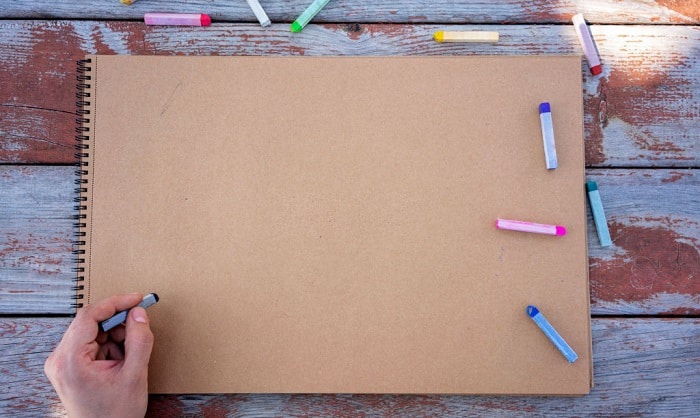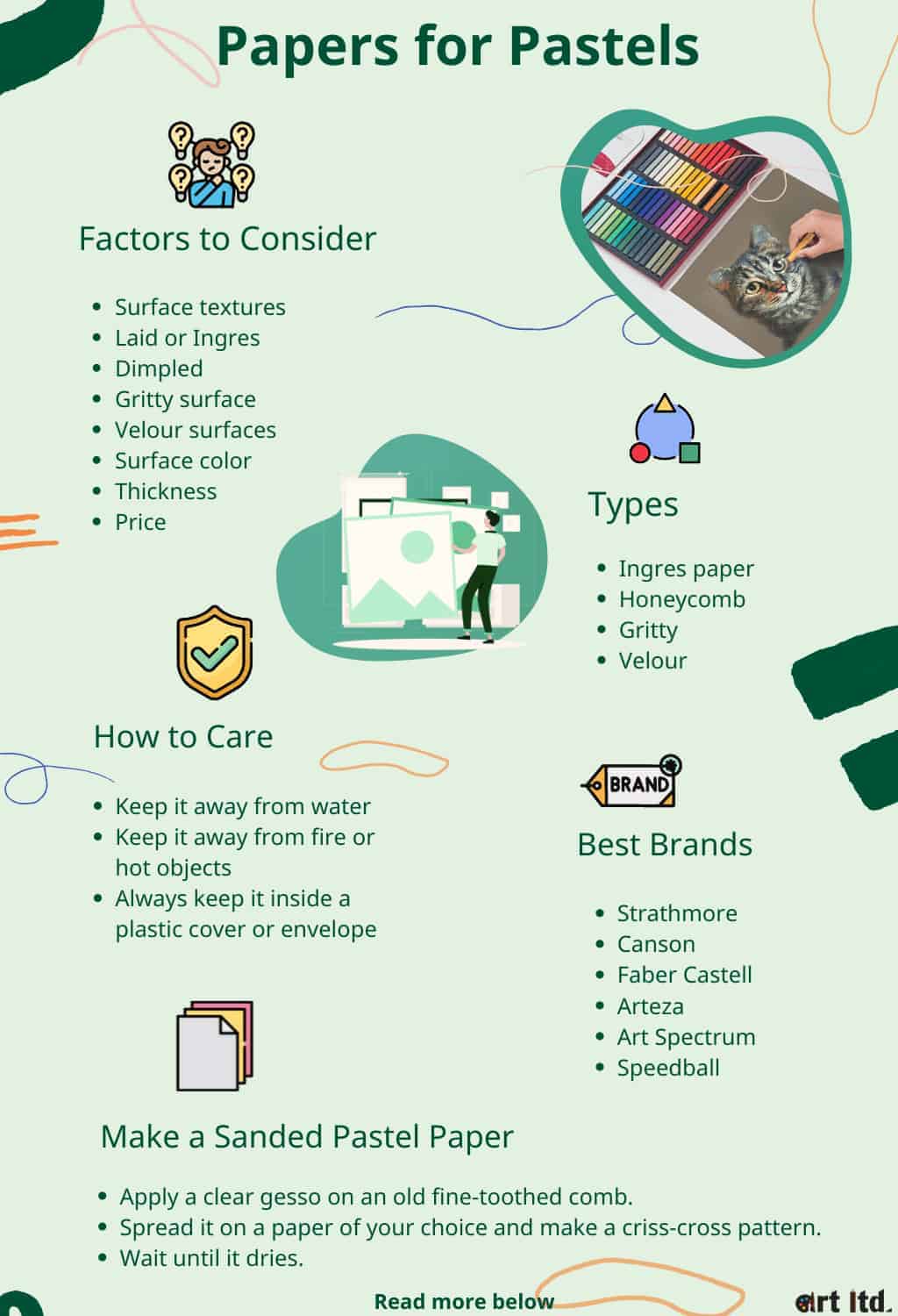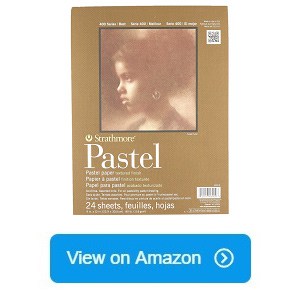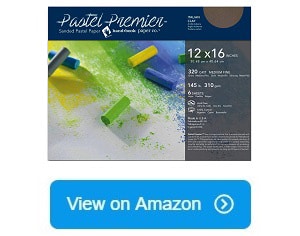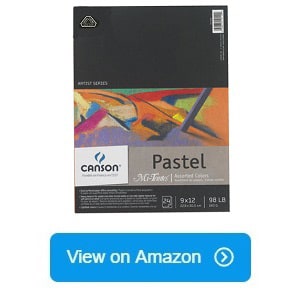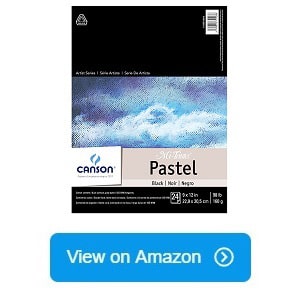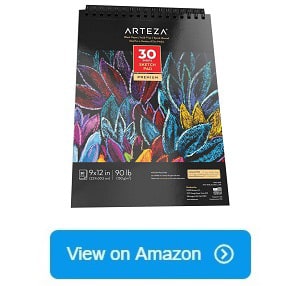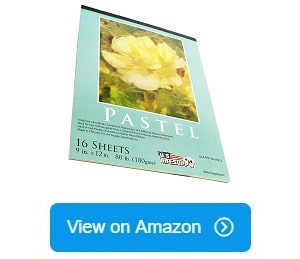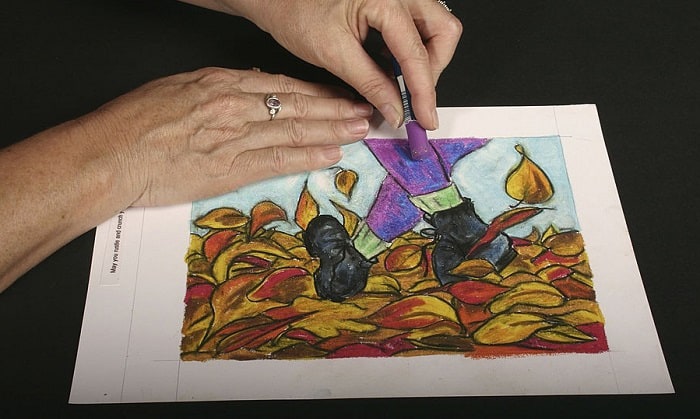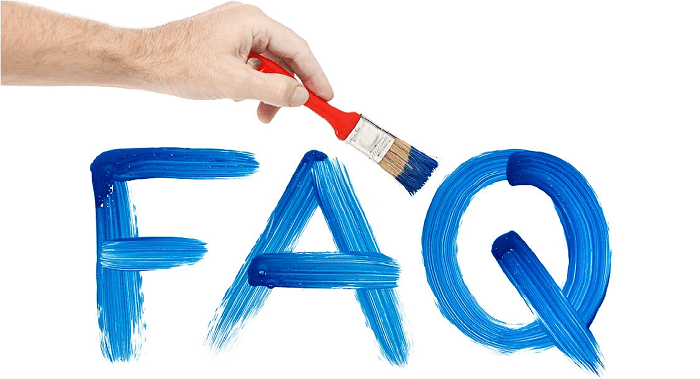A visual artist who prefers pastels or chalk must certainly have the best paper for pastel at his disposal all the time. Having a good supply of fresh paper helps them translate your artistic ideas properly. This kind of issue does not bother artists with advanced skills. However, this is definitely an added worry to beginning artists who are just learning the tricks of the trade.
If you are a beginner and you want to improve your pastel skills, one of the things that you need to learn is the different types of papers for pastel. In this article, we can help you expand your horizon by giving you details about brands and types of pastel art paper. This way, you will be able to determine which ones to use if you want to practice certain techniques.
Table of Contents
- Best Paper for Pastels Reviews
- 1. Canson XL Series Mix Paper Pad
- 2. Strathmore 400 Series Pastel Pad
- 3. Speedball Art Products 513046 Pastel Paper
- 4. Premium Sketch Book
- 5. Mi-Teintes Pastel Pad, Assorted Colors
- 6. UART Sanded Pastel Paper M-148931
- 7. Canson Drawing Mi-Teintes Paper Pad
- 8. ARTEZA Black Sketch Pad
- 9. Strathmore 400 Series Artagain Pad
- 10. Canson XL Series Black Drawing Paper
- 11. AmperSand Museum Series Pastelbord
- 12. U.S. Art Supply Premium Pastel Paper Pad
- What to Look for When Buying Paper for Pastels
- Other Important Factors to Consider
- Frequently Asked Questions
- Conclusion
Best Paper for Pastels Reviews
1. Canson XL Series Mix Paper Pad
I am a digital entrepreneur and have been blessed with a twin. My growing business allows me to stay home and raise them while making a living. These days, my husband and I are trying our best to engage them in creative arts. I worked part-time in my aunt’s craft store in Hawaii when I was in college and learned about drawing and DIY crafts.
We purchased four of these Canson XL Series online to begin a humble art class. We want our kids to express themselves and inspire them to be productive through art-making. They started using small amounts of watercolors and acrylics on their own paper pad. Now they don’t want to stop painting because these papers do not shrink or get distorted. The pages are just a bit wavy which is expected when painting on paper though. The wire binding makes it easy for them to open, turn, and fold the pages because it lay flat.
In addition to that, this pad is fairly inexpensive but the quality was not traded. There was no bleed-through on my artworks yet. I’ve been using this pad to recreate my mother’s recipe portfolio. I love sketching the ingredients using Ohuhu markers and coloring them with my Derwent colored pencils. They can be used wet or dry and the watercolor effects are intense and gorgeous on this pad. And now I’m addicted! I plan to send them soon to my mother whom I haven’t seen for some time.
- Sturdy and fine texture paper
- Suitable for wet and dry media
- True size 7″ x 10″ sheets
- Contains 60 sheets of acid-free paper
- Not suitable for multiple marker layering
2. Strathmore 400 Series Pastel Pad
I am a sucker for DIY crafts and my daughter encouraged me to take up an art class since I have plenty of time during their vacation in England. I was in 5th grade when I learned to paint and draw and I really felt I have been left behind with my age. Eventually, I took the nerve and picked up a paintbrush to start my creative pursuits.
I began an introductory-level class and found my niche in creating still life sketches. My favorite subjects are flowers and banquet pieces. I started with the Strathmore 400 series as my instructor suggested. The papers come in lovely shades (light blue, tan, off white, and light gray). With these colors, I was able to play around with different imaginative effects. It’s cool that they work well for graphite pencil, soft pastels, charcoal, and colored pencils too. Versatility, huh?
I often travel within the country for our family business and since this Strathmore pastel paper is very small and lightweight I was able to carry it along. This instantly became my go-to pastel pad and I love that I didn’t have to spend much on this without compromising the quality.
It has a really nice tooth and I worked on it using soft pastels and colored pencils which hold up quite well because of the rough finish. I haven’t tried it on oil pastels but I heard they can hold one or two layers of oil. Also, I came to love this because it is acid-free and kept my drawings intact and free from yellowing.
- Acid-free papers with lovely shades
- Versatile and could be used to numerous mediums and styles
- Small and lightweight
- Good value for money
- Not the best paper to hold chalk
3. Speedball Art Products 513046 Pastel Paper
To balance my emerging business and parenting, I often shave my schedule off on weekends to bond with my kids. I am happy that at an early age they are willing to practice their craft skills with me. My daughter loves pottery and has made adorable containers for our indoor plants. My son, on the other hand, prefers drawing on walls and furniture. And as we engaged in crafts and art-making they are also growing into self-sufficient individuals.
On Thanksgiving, my husband sent me an artist’s craft box including this sketchpad from Speedball. This wonderful sketchpad includes six neutral sheets of Italian clay paper and comes in White, Buff, Terracotta, Slate (dark, cool gray), and Italian clay (warm neutral gray). It’s cool that Pastel Premier made this using 100% cotton and free from acid which is of archival quality.
It’s lightweight, at just about half a pound. It’s available in two surfaces, a smoother and finer surface (600 grit) in white, and the rest of the colors have a toothy and aggressive surface (320-400 grit). The distinctive surface has an evenly coated surface for my pastel on paper paintings.
I love working my Plein air landscape pieces on the Terracotta paper because it makes them look more luscious, intense, and vibrant. The overall clay color also provides a subtle and soft background and holds my NuPastels and Rembrandt’s soft pastels really well. I created a photorealist painting of our cat on the smoother paper with oil and soft pastels and got a rich painterly effect. I heard that it would also work on wet media and I’m excited to try it on my under-painting projects.
- Made of 100% cotton paper
- Evenly coated with aluminum oxide abrasive
- Has one smooth and five toothy surfaces
- Acid-free
- Not suitable for multiple layering
4. Premium Sketch Book
This was the very first sketchpad I’ve used when I began to draw and sketch a couple of years ago. I often travel to keep my business going and it became my creative outlet to put my feelings on paper and relieve stress. When my schedule permits, I spend quality time with my daughter by checking out new art stuff and making DIY crafts at home. Well, we are both artistic in nature and share the same fondness for fancy drawings.
The number of pages in this sketchbook is a bang for the buck and allows me to experiment on different dry mediums. Also, this is taped bound and it is not difficult to peel off each page, but not too loose that they’ll get detached when you don’t want it to. I love that it comes in an off-white color and makes my pieces warmer and tranquil. Occasionally, I put a very subtle finishing touch on the background to emphasize my subject.
Over the years, I have drawn some incredible landscapes of the countryside using black gel pens on these papers. I’m currently working on another artwork using graphite pencils and to add details and depth, I use my current favorite marker, a bamboo dip pen. I got lovely textured lines as the ink runs out and the pen gives me a lot of variation in line thickness. It was fun to experiment on this sketchpad using newly found tools. This really suits my creative needs because I prefer black and white illustrations through pencils and pens over other drawing methods. Well, it all boils down to personal preference, right?
- High-quality Sketchbook
- Has a standard 9″ x 12″ paper size
- Came in Off-white color
- Suitable for dry media
- Not enough texture to hold pastels
5. Mi-Teintes Pastel Pad, Assorted Colors
Painting became my go-to distraction while managing our family business. I have tons of art supplies at home including this Mi-Teintes pastel pad. I adore this pad because of the convenient color-themed selection. The lovely assorted colors are perfect for my pastel paintings!
This pastel pad features a uniquely double-sided surface that I didn’t get from the other brands. The top part has a “vellum” texture and the reverse side has a flat surface. My favorite medium to work in them is oil pastel. My children love using chalk pencils, acrylic, and watercolors. We love how this chalk pastel paper produced amazing works of art at home, from figure drawings to gorgeous portraits.
This is an excellent paper for my creamy Sennelier oil pastels. I have no problems overlapping two to three thick layers because it holds and achieves the depth of colors without damaging the paper. It’s like working with real oil paints and blending is as easy as pie. My floral pieces have a rich vibrant look on them and they stand out in our dining walls. Moreover, it comes in subtle colors such as buff, champagne, moonstone, light blue, steel gray, and eggshell white. These colored papers work effectively for portrait and landscape backgrounds too. I don’t have to color the whole surface and it makes them more realistic and convincing.
- Suitable for a wide variety of dry and wet mediums
- Gelatin-sized papers and made of 50 percent cotton
- Dual-surfaced: light and heavy textured on opposite sides
- Lightfast and acid-free paper
- Only 24 sheets inside the pad
6. UART Sanded Pastel Paper M-148931
I have loved arts and crafts since I was a teenager. And from then I have drawn and painted tons of artworks. In the past, I only used traditional art supplies and as I got drawn more to painting, I have collected a number of modern tools. One of them is this sanded pastel paper from UART. I am an entrepreneur and whenever I can squeeze my kids into my busy schedule, we spend time making fun art and stuff at home. Sometimes, we go out to find inspiration and paint in the park just around our block.
UART became my favorite pad because it is the only paper in the market today which offers seven grades. I can choose to work in 240(coarse) to 803(finest) grits. The color resembles fine beach sand. My first commissioned piece was made on this 400-grade paper using pan pastels and my Prismacolor Verithin colored pencils. For abstract paintings, charcoals and soft pastels glided down smoothly and blended really well on this grade. There is also minimal dust left behind and it was easy to clean.
From my experience, my portraits on this paper looked more vivid and intense compared to pastel papers. It has a very reliable texture and takes a wide range of wet media without compromising the grit. Layering multiple oil pastels worked like a charm and the good thing is I don’t have to use any fixative at all, making me feel like this is the top-rated paper for oil pastels. No need to fret about making mistakes because covering them is like a breeze. Furthermore, the grit accepts water wash and holds multiple layers without risking a muddy look. I got painterly effects by combining colored pencils and Gamsol on my lifestyle portraits too.
- Acid-free and ph neutral
- Available in seven grades from 240 to 803
- Works well with wet media for underpainting techniques
- No fixatives needed
- Pricey for a pack of 10 sheets
7. Canson Drawing Mi-Teintes Paper Pad
This sketch pad contains 24 gelatin sized papers. Mi-Teintes has very good lightfastness properties too and could withstand the light exposure to avoid fading or color change. This world-recognized paper is made of 50 percent cotton and is 160 gsm thick.
One cool factor is the versatility of these papers. Aside from painting it with oil and my Ludwig’s soft pastels, I was able to use my Winsor and Newton gouache on it, the velvety matte finish was very satisfying. I had a specific commissioned piece made from these two and was paid handsomely. This is how I turned my hobby for painting into a business venture.
This has been my preferred sketchpad for portraits because of its pitch black and dual-textured surface. It has a lighter texture on one side and I really love how I got an impressionistic effect just by simply using my colored pencils and permanent ink pens.
On the slightly rougher side, I started on dark shadows with ease and shifted to subtle colors with lots of white layering. I made our family portrait using my pastel pencils and pen colors with opaque ink which made it more realistic. I hung it on our hallway walls and it added life and made our home look more inviting. I also added two lamps on each side which greatly attracts my guests’ and clients’ attention to our portraits. It is one of my most treasured artworks.
- Gelatin-sized papers made up of 50% cotton
- Dual textured surface (smooth and fine grain)
- Suitable for various and mixed mediums
- Acid-free and fade resistant
- Few sheets in a pad
8. ARTEZA Black Sketch Pad
I built my business as an affiliate marketer several years ago. I had helped brands to endorse their merchandise and services online. With this, I got to enjoy a flexible time with my family at home. My daughter’s hobby was to splatter and paint everywhere when she was younger. Now that she is in her teens and with summer on its way, we decided to keep her creativity going.
Since she is hooked into outdoor drawings, I purchased this inexpensive Arteza sketchpad to flourish her art routine. I have one for myself too! These are perfect for on the go drawings because it is spiral bound. I can flip it all the way back and lay flat easily when sketching. Pretty manageable, right? It comes in a pack of two and contains 60 micro-perforated black sheets. It’s good that it carries its true size and each sheet is acid-free. My girl’s favorite art tool on this pad is her metallic paints and opaque gel pen from Sakura. Her gorgeous drawings are dreamy and stand up to the darkness!
I was surprised that this sketchpad can be used with a wide range of craft projects and drawing mediums. Since the background is almost charcoal black, I tried to transition my sketches from gray to white marks using my Derwent’s white charcoal pencils. It’s like I’m being sucked into space while working on it. Also, I love how I can easily shade the page and build up the volume through the hatching method. I was able to strongly highlight our adorable cat’s portrait, my first priceless artwork on this pad. I had a wonderful time experimenting with paint pens on still life pieces too. It was super smooth and the paint glides beautifully on these black pastel paper.
- 360 degrees spiral-bound
- Ideal for a wide variety of dry media
- Contains 60 black micro-perforated sheets
- Acid-free
- Has a chemical smell
9. Strathmore 400 Series Artagain Pad
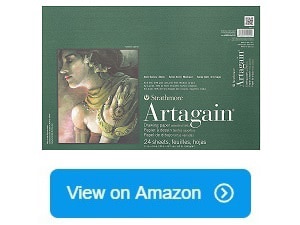
It is a medium weight paper and comes in assorted lovely hues of beach sand ivory, desert rose, storm blue, moonstone, Gotham gray, and steel gray. It also has a sturdy chipboard backing and an easy flip-over cover. My son used the moonstone and storm blue for watercolor painting in his class because the canvas is too expensive. I love that it works on subtle amounts of wet media without being damaged.
I made painted gift cards using the desert rose and beach sand ivory papers on St. Patrick’s. My favorites are the gray tones for my black and white charcoal sketches. It was much easier to judge light and bring depth to my portraits. Blending was easy and erasing mistakes do not impair the paper using the right eraser. There is minimal dust too! Also, it’s nice that they are acid-free because I would love to preserve my art pieces for a long time as much as possible. I want them to still look as fresh and vibrant as if I just painted them yesterday.
- Fiber-enhanced paper, ideal for soft pastels and charcoal
- Contains 24 sheets of assorted tints
- Has a sturdy chipboard backing and flip-over cover
- Acid-free
- Could not be considered as archival quality
10. Canson XL Series Black Drawing Paper
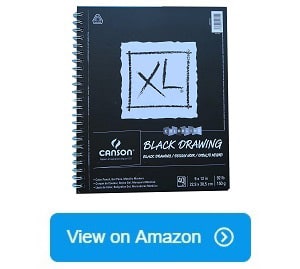
I love mysterious and melodramatic paintings and the Canson XL Series Black Drawing Paper suits my drawing style. The contrast between light and dark is incredibly dramatic on each page. It is wire bound and comes in 40 true to size sheets. It has a fine-tooth surface and works flawlessly on my favorite mediums. Also, this pad uses high-grade tint and is acid-free which helps me preserve my art for a long time. It’s really good because the colors are still vivid.
One technique that I’ve learned from other artists online is to first swatch the colors to see which will show the prettiest color and highlight the subject for a stronger sense of drama. I’ve pretty much-used graphite pencils, a black eraser and colored pencils from Prismacolor on these pages. It brings out more vibrant and gorgeous colors and the effect often looks like paintings and dimensional. The highest grade pigment used on this paper matches the rich pigments of the pencils thus, it was easier to blend the colors. Working from dark to light makes building up tonal shades effective too. Hatching, shading, and layering on this pad are pretty smooth and satiating.
- Awesome beater dyed paper
- Perfect for a wide variety of dry media
- Features the highest grade pigments
- Acid-free paper and guarantees longevity of artworks
- Not ideal for mixed media that involves a wet medium
11. AmperSand Museum Series Pastelbord

I used traditional art supplies before switching to this pastel board from AmperSand. I bought several pieces in different sizes for my colored pencil and pastel work. And I love how it easily worked well on my painting style because of the very firm board and coated panels. It has some teeth in it which is much better than a pastel paper but not as sanded as Pastelmat does.
The sanded board is good enough as a background for underpainting itself. It is truly flexible because of its solid hardboard backing. It can withstand multiple layering of chalk pastels and blending it with filtered water makes the colors more vibrant and more paint-like.
I had fun using big brushstrokes of thin paint on the smooth absorbent clay ground. It also has the same effect when various liquids like water and acrylic are combined. My Faber Castell hard pastels remained rich and glowing after underpainting on this board. Not only that, but this also has an acid free ground that isolates the wood panel from a painting surface. I am confident that it will not discolor over time. Also, this hardboard was made using a completely green process and it is formaldehyde-free. Being eco-friendly and safe for end-users like me is quite favorable.
- Hardboard panel is gesso coated
- Has an even marble dust finish
- Has a neutral Ph
- Can be used on mixed media
- Comparable to sanded paper
- Had a hard time making a little spot of the board to accept the pastel
12. U.S. Art Supply Premium Pastel Paper Pad
If you are looking for pastel paper that is a bit on the heavier side, this pad from US Art Supply is a good choice. With a thickness of 180 gsm, it is heavier than your typical paper.
What I love most about this pad is that it has a natural tone. It’s easier to create portraits as I only need to use very little color for the skin tone. Apart from soft pastels, I was also able to use this with other media such as charcoal, hard pastel, oil pastel, and colored pencil. I wouldn’t recommend using it with watercolor though, as this paper can’t hold wet media well.
All the sheets are very tightly glued, which can be advantageous and disadvantageous at the same time. You won’t have to worry about your artwork getting detached easily. However, it can be problematic if you really intend to tear a piece off, to frame it for instance, the paper won’t tear away nicely.
When it comes to applying soft pastels, it works perfectly. The paper is a bit smoother than others; the tooth is finer. Nevertheless, it can hold the pastels enough.
- Has a neutral pH
- Great for multiple media except for wet media
- Acid-free
- Has four shades of natural tones
- The binding is too tight that it’s hard to tear a paper off evenly
What to Look for When Buying Paper for Pastels
Sometimes, your paper choice can spell a huge difference when you are drawing using pastels. It can either make or break your artwork. This is the reason why many artists, both beginners, and pros pay a great deal of attention to the paper that they are using.
In this article, we’re going to discuss what works, what doesn’t, and what you should spend your money on when it comes to papers for pastels. This for you to determine which product will make your work intense.
Surface textures. There are different kinds of surface textures that you can work with. This is commonly referred to as the ‘tooth.’ This is the valleys and peaks on the surface of the paper. When you are buying paper for pastels, the tooth on the product will determine how your artwork is going to look like.
There are various surface textures that you can choose from. These are:
Laid or Ingres. Ingres has a distinctive surface characteristic. One thing to determine this is by feeling the grid line or criss-cross pattern on the surface of the paper.
There are many pastel paper brands that do their own version of Ingres paper. Since this type of paper surface is quite popular and easy to make, they are very affordable.
The best thing about the laid or Ingres is that you can navigate the pastel smoothly and blend colors easily. The downside is that it can be hard to get a sharper detail due to the large gaps between troughs and peaks. In order to overcome this downside, you have to rub more pastel to cover the pattern.
Dimpled or honeycomb surface. This texture is just like Ingres. The only difference is that instead of criss-cross, you will see a honeycomb pattern on the surface of the paper. This type of paper is a little bit pricey compared to Ingres, but it’s still affordable. In terms of layering and blending, it is at the same level as the Ingres. You can perform limited layering and easy blending.
Gritty surface. Gritty papers have a sandpaper feel, though not as harsh as the real thing. Because of the surface texture, the pastel grips easily and equally, even if you applied many layers of bright colors. What’s great is that you can still apply a bright white highlight on top.
If you are budget conscious, you should know that gritty papers are quite pricey. For beginners, it is advised to use this paper only for serious artworks. You can practice on other paper types until you are confident enough to use gritty papers.
Velour surfaces. Velour surfaces are known for their velvety characteristics. This type of paper may seem a bit slippery, but the pastel adheres to it amazingly well.
Of all the paper types for pastels, this one is the most pricey. This type of paper takes longer to get used to, so use it only if your skills and confidence have leveled-up.
Surface color. Contrary to popular belief, not only white-colored papers can fully bring your ideas to life. Sometimes, other surface colors can help you translate your artistic ideas. There are colors of pastel papers that can bring your ideas better than the other. As a beginner, you need to experiment more often to determine which ones agree with your own aesthetic tastes.
Thickness. In terms of thickness, you will notice the term GSM. This acronym stands for grams per square meter. The rule of thumb is that the higher the number, the thicker or heavier the paper is. If you are going to buy your paper for pastel, make sure that it is at least 175 GSM.
Price. If you are a beginner, you need every cent to work in your favor. Buying expensive soft pastel paper is not an advisable option for beginners. In order to develop your skill, you need to start on the most affordable type of paper, which is the Ingres. You can purchase other paper types only if you think that your skill has reached another level.
Knowing the things discussed above will save you time and money when shopping for paper for pastel. In addition, this will give you more chances to improve your craft because you won’t be held back by logistical constraints
Other Important Factors to Consider
What is the best paper to use for pastels?
Knowing the best paper for your pastel paintings can be challenging. Beginners often struggle to find the right paper type to practice their pastel skills because they have no idea where to begin. This lack of knowledge often leads to a waste of both time and money.
If you are a beginner, you definitely need to know the different types of paper and learn when to use them. Here are some ways that can help you determine the best paper to use for your pastel-based artwork:
Surface type. Since you are a beginner, you need to use the most commonly used type of pastel art paper. This is the Ingres or Laid paper. Ingres is the cheapest pastel sheet to practice with. With this type of paper, you will not waste precious money even if you rip to pieces if you think you got it wrong.
As you develop your skill, you can now progress to other surface types such as the honeycomb, gritty, and finally – velour.
Technique. The technique that you are going to employ in a pastel painting is another reason why you need to choose the right paper. If you need to practice your blending technique, the best paper to use is Ingres. If you want to improve your layering, you need to do it on a gritty paper. However, if you believe that you have leveled-up your skills, and you want to experiment a little, the best paper for the job is velour.
How does it work?
As we all know, not all paper types work well with pastel. Most of the time, the kind of paper that a beginner uses to hone his drawing or painting skills is the one with a smooth surface. This type of paper is normally used for writing or printing. Little did they know that there is a special paper that can be used to fully realize an artist’s vision on paper. This is the pastel drawing paper.
Paper for pastels has a special feature that makes that pastel adhere properly. This feature is found on the surface. Artists usually refer to this feature as “tooth.” The tooth is the measurement of the paper’s quality. The rougher the surface, the more the pastel sticks.
For instance, the cheapest and the most common paper for pastel is the Ingris. The next, which is a step higher than Ingris is the honeycomb surface. The next one is called gritty paper, which has the characteristics of sandpaper. Finally, the paper that advanced artists use is velour paper. It has a surface that feels velvety, which creates a beautiful “soft pastels on canvas” effect.
Who is this for?
Paper for pastel is for anyone who is interested in pastel drawing or painting. Traditional papers used for writing or printing do not have the tooth or surface needed to make the pastel adhere properly. This is the reason why a special type of paper was developed for pastel artists.
If you are interested in developing your pastel painting skills, you need to get yourself a good pastel paper. However, since these papers have their own purpose, they don’t come cheap.
What are the different types of pastel paper?
Creating great artwork like a pastel painting requires the right type of canvas. However, not all beginning pastel artists know the different types of pastel papers they can use. If you wish to bring your pastel skills to another level, you need to have a trustworthy brand of pastel paper to practice on.
Here are some of the types of papers that you can practice your skills on:
Ingres paper. This type of paper has a distinct characteristic of criss-cross on the surface. If you wish to improve your blending technique, this is the ideal pastel paper for you. You can easily get this type of paper because it is very affordable.
Honeycomb. If you want to perfect your layering and blending, this is the right paper for you! The most distinguishable feature of this type of paper is the honeycomb shape pattern the criss-cross lines make. This is slightly pricey compared to the Ingres but it is still affordable.
Gritty. A gritty pastel paper is known for having a sandpaper-like characteristic. Because of the rough texture, pastel easily adheres to its surface. This is the best paper to use all of the techniques that you have learned so far. However, gritty papers are pricey compared to Ingres and honeycomb, so make sure that you use it only if you are confident enough with your skills.
Velour. Velour has a texture of velvet, so you won’t easily confuse it with the rest. This particular pastel paper is for artists with advanced drawing skills. If you are only looking for a paper to practice on, this is not the right paper for that. After all, out of all the types of pastel paper, this is the most expensive one.
Knowing the different types of pastel paper can help you improve your techniques significantly. Using the wrong paper type for practicing will surely result in a waste of paper and pastel.
Why do you need pastel paper?
You would typically encounter issues with using ordinary paper for your pastel artwork. The medium will either not blend well, you cannot add layers, or the paper will altogether reject the pastel!
Paper for pastel painting is a requirement if you want to create a captivating artwork using pastels. Without it, an artist won’t be able to fully translate his or her ideas.
Frequently Asked Questions
What are the most trusted pastel paper brands?
Finding the right pastel paper brand is one of the most challenging tasks for a pastel painter. You need to have the right paper to execute your ideas and transfer them into the paper. Believe it or not, the paper can help the artist use his techniques well.
For a beginner like you, finding the right paper brand can feel like an added burden. Fortunately, some visual artists have revealed their secrets including their favorite brand of pastel and paper. Here are some of the most trusted brands of pastel art paper that you can try:
- Strathmore
- Canson
- Faber Castell
- Arteza
- Art Spectrum
- Speedball
You have to remember it is the artist who ultimately decides which brand of pastel paper he or she is going to use.
Is mixed media paper good for pastels?
Being an artist requires an open mind. One of the things that you may encounter on your journey as an artist is an invitation to experiment. One of the things that may get your attention is the mixed media paper.
Mixed media paper is a type of paper that has enough teeth to accommodate non-translucent or opaque paints, inks, and markers. It can also accommodate pastels such as soft, hard, oil, and PanPastels. If pastel papers are not available in your area, you can try to explore possibilities with mixed media paper.
Can you paint on pastel paper?
This is one question which many beginner painters ask. Painting on pastel paper is only possible if you use acrylic paint. This is due to the fact that most pastel papers are composed of at least 20% of wood pulp. The paper is hard enough to contain the paint on one side and prevent it from bleeding on the other side.
How do you use hard pastels?
During your journey as a pastel artist, you will decide to use hard pastels along the way. If you are totally new to pastels, you need to know that there is nothing to be afraid of hard pastels.
Basically, there are ways to use a hard pastel. These are:
- Initial application. This refers to the application of thin layers of color and eventually thickening it as you progress.
- Broken color application. In art, broken color refers to the method of building up layers of various colors on the paper allowing other layers to be exposed. The result is a vibration of color, as the viewers’ eyes jump from one color to another.
- Softening and blending. As hard pastels are more durable compared to soft pastels, you can use this to blend the colors instead of using your fingers or a tissue paper. Usually, soft pastels are more suited for adding another layer of colors, but it would supply too much color on the paper so hard pastels are far more ideal for this job.
Learning how to use hard pastels can help you expand your coloring techniques. In addition, it can help you save your soft pastels because the hard ones can take good care of adding more color.
How do you make sanded pastel paper?
Sometimes, artists have moments of financial difficulties. When pastel paper is not available, you need to improvise and experiment a little in order to execute your artistic ideas. Making your own sanded pastel paper will help you save money and personalize your artwork more.
Here is how to make a sanded pastel paper:
- Apply a clear gesso on an old fine-toothed comb.
- Spread it on a paper of your choice and make a criss-cross pattern.
- Wait until it dries.
You have to remember that a personalized sanded pastel paper may not be as conducive as the real thing. Just remember, though, that the tooth may not be as consistent compared to the machine manufactured ones. However, this will allow you to practice your pastel techniques until you get your hands on the real ones.
Where to buy?
You can buy your pastel paper at your favorite art supplies store. You can also purchase them at Lowes, Home Depot, Target, and other supermarkets. However, if the specific brand of pastel paper is not available, you can always try to look for them online. Amazon.com is the best online store to start your search for your preferred pastel paper brand.
How to care for the paper and make it last?
If you are into pastel painting, you need to know that your pastel paper is an integral part of your craft. Learning how to take good care of it will help you produce awe-inspiring artwork every time inspiration comes.
Here are some ways to take good care of your pastel paper:
- Keep it away from water. Water can affect the quality of any paper, especially the pastel paper. The tooth on the surface of the paper will certainly soften, which can adversely affect the technique that you are going to employ on the artwork. As much as possible, stay away from water whenever you are working with your pastels.
- Keep it away from fire or hot objects. Exposing the pastel paper on fire or any hot objects can ruin it. It can curl or have a brown stain on some parts.
- Always keep it inside a plastic cover or envelope. Keeping your unused pastel papers inside a plastic cover or envelope can help you maintain its quality. This way, even if you have an accident while drawing, the papers are safely tucked away.
These suggestions are just some ways to help you keep the quality of your pastel papers top notch. Keeping them safe can also help you save money, especially if you have a limited budget.
https://www.youtube.com/watch?v=7eemmXFLqAg
Conclusion
Knowing a great deal about pastel papers can really help a beginning artist realize their full potential. If you are a beginner, it pays a lot to know more about the types of paper that you will encounter along the way. However, in addition to practicing your skills on a regular basis, knowing different types of pastel papers can be a great burden to you. But for you to become a good pastel artist, you need the best paper for pastels at your disposal at all times.
You have to remember, though, that using pastel sheet papers cost money. Before using an expensive piece of paper such as velour, make sure that you are confident enough or your skills are developed. Until such time that your skills have fully developed, make sure that you use Ingres or honeycomb pastel paper. These types of papers are considered to be more affordable compared to gritty and velour.

I am a former art teacher, so it is evident to me the importance of art in educating the new generation. We also want to help parents who plan to teach their children and desire the best tools and tips for them.
